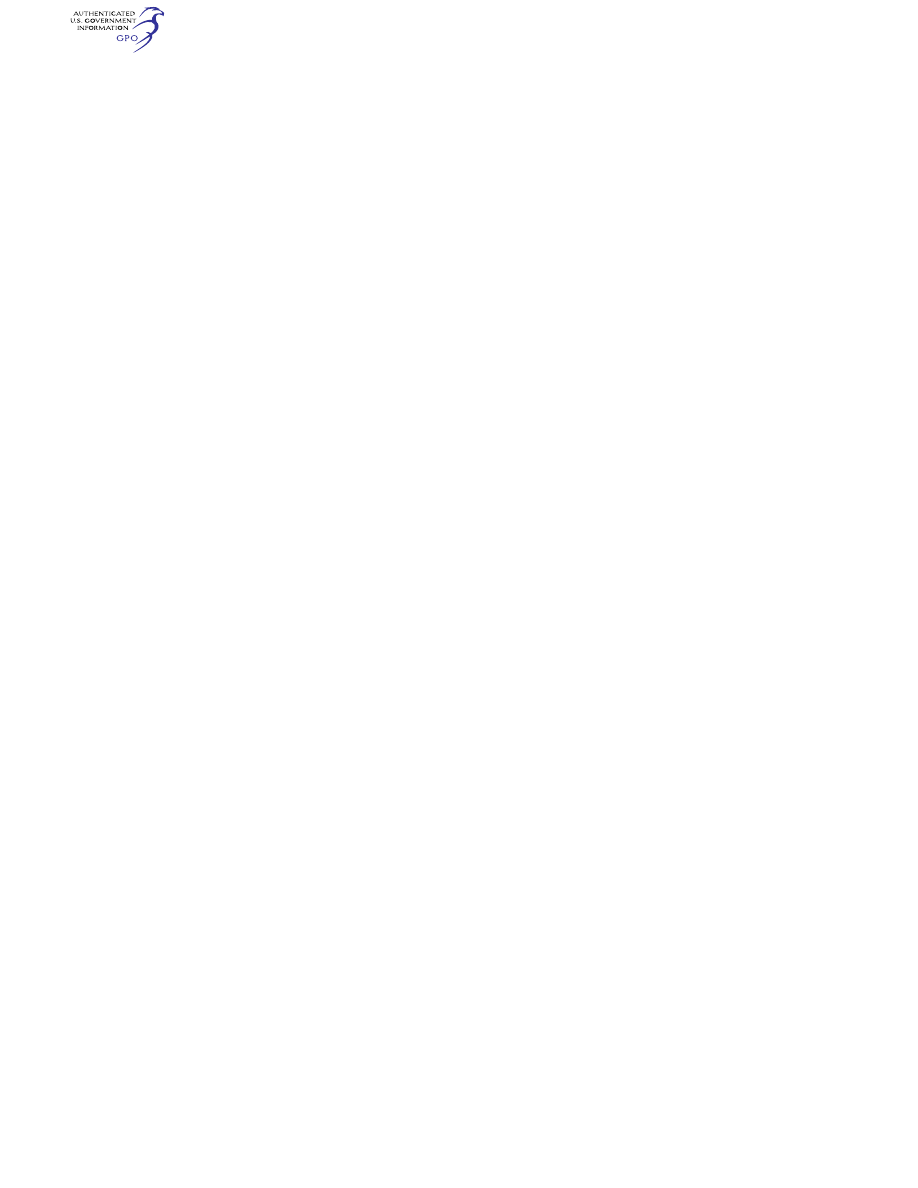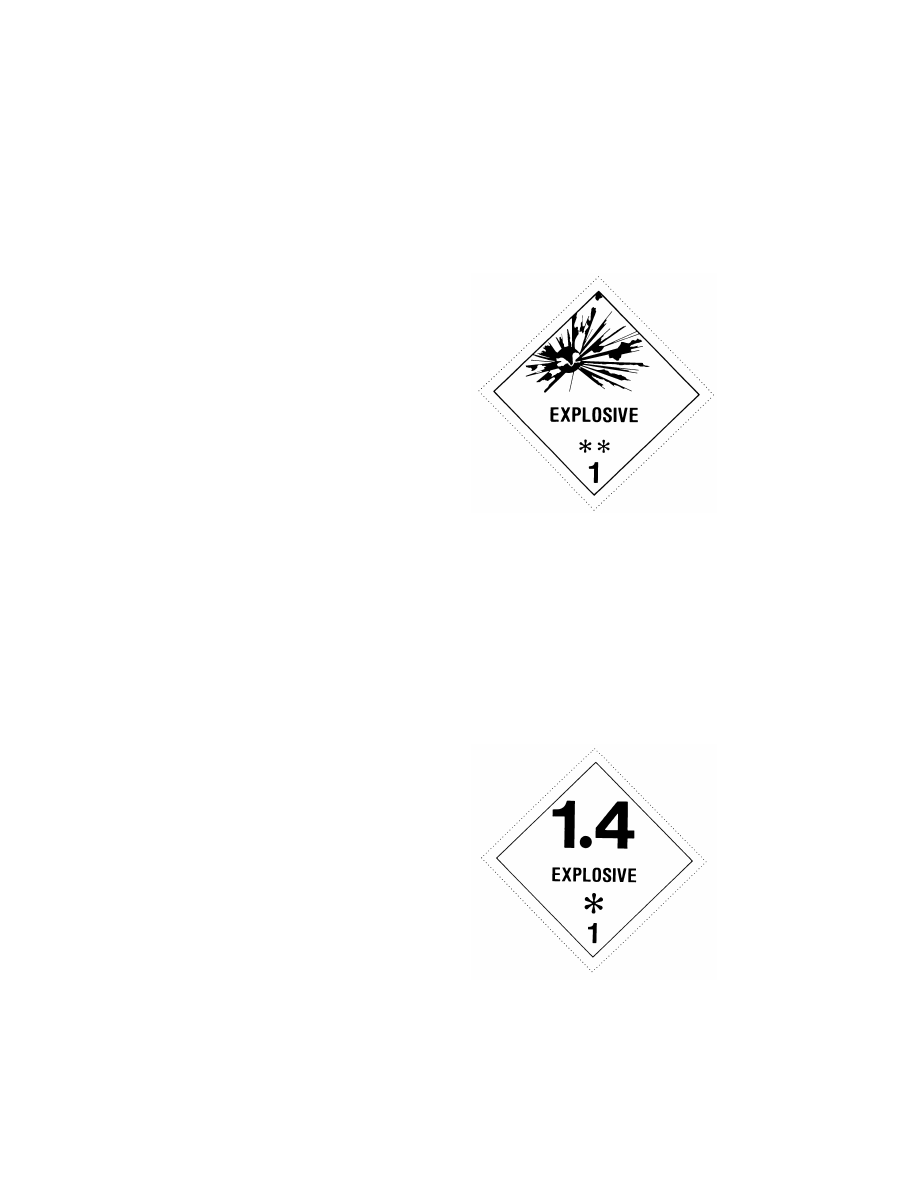
423
Pipeline and Haz. Matls. Safety Admin., DOT
§ 172.407
side of the package. For cylindrical
packages, the label must be of such di-
mensions that it will not overlap itself.
In the case of cylindrical packages con-
taining radioactive materials, which
require two identical labels, these la-
bels must be centered on opposite
points of the circumference and must
not overlap each other. If the dimen-
sions of the package are such that two
identical labels cannot be affixed with-
out overlapping each other, one label is
acceptable provided it does not overlap
itself.
(2) Except as provided in paragraph
(e) of this section, duplicate labeling is
not required on a package or contain-
ment device (such as to satisfy redun-
dant labeling requirements).
(b)
Exceptions.
A label may be printed
on or placed on a securely affixed tag,
or may be affixed by other suitable
means to:
(1) A package that contains no radio-
active material and which has dimen-
sions less than those of the required
label;
(2) A cylinder; and
(3) A package which has such an ir-
regular surface that a label cannot be
satisfactorily affixed.
(c)
Placement of multiple labels.
When
primary and subsidiary hazard labels
are required, they must be displayed
next to each other. Placement con-
forms to this requirement if labels are
within 150 mm (6 inches) of one an-
other.
(d)
Contrast with background.
Each
label must be printed on or affixed to a
background color contrasting to the
color specification of the label as re-
quired by § 172.407(d)(1), or must have a
dotted or solid line outer border, to en-
hance the visibility of the label. How-
ever, the dotted or solid line outer bor-
der may also be used for backgrounds
of contrasting color.
(e)
Duplicate labeling.
Generally, only
one of each different required label
must be displayed on a package. How-
ever, duplicate labels must be dis-
played on at least two sides or two
ends (other than the bottom) of—
(1) Each package or overpack having
a volume of 1.8 m
3
(64 cubic feet) or
more;
(2) Each non-bulk package containing
a radioactive material;
(3) Each DOT 106 or 110 multi-unit
tank car tank. Labels must be dis-
played on each end;
(4) Each portable tank of less than
3,785 L (1000 gallons) capacity;
(5) Each freight container or aircraft
unit load device having a volume of 1.8
m
3
(64 cubic feet) or more, but less than
18 m
3
(640 cubic feet). One of each re-
quired label must be displayed on or
near the closure; and
(6) An IBC having a volume of 1.8 m
3
(64 cubic feet) or more.
(f)
Visibility.
A label must be clearly
visible and may not be obscured by
markings or attachments.
[Amdt. 172–123, 55 FR 52594, Dec. 21, 1990, as
amended at 56 FR 66255, Dec. 20, 1991; Amdt.
172–130, 58 FR 51531, Oct. 1, 1993; 73 FR 4716,
Jan. 28, 2008; 81 FR 35540, June 2, 2016; 87 FR
44991, July 26, 2022]
§ 172.407
Label specifications.
(a)
Durability.
Each label, whether
printed on or affixed to a package,
must be durable and weather resistant.
A label on a package must be able to
withstand, without deterioration or a
substantial change in color, a 30-day
exposure to conditions incident to
transportation that reasonably could
be expected to be encountered by the
labeled package.
(b)
Design.
(1) Except for size and
color, the printing, inner border, and
symbol on each label must be as shown
in §§ 172.411 through 172.448 of this sub-
part, as appropriate.
(2) The dotted line border shown on
each label is not part of the label speci-
fication, except when used as an alter-
native for the solid line outer border to
meet the requirements of § 172.406(d) of
this subpart.
(c)
Size.
(1) Each diamond (square-on-
point) label prescribed in this subpart
must be at least 100 mm (3.9 inches) on
each side with each side having a solid
line inner border approximately 5 mm
(.2 inches) inside and parallel to the
edge. The 5 mm (.2 inches) measure-
ment is from the outside edge of the
label to the outside of the solid line
forming the inner border.
(i) If the size of the package so re-
quires, the dimensions of the label and

424
49 CFR Ch. I (10–1–23 Edition)
§ 172.407
its features may be reduced proportion-
ally provided the symbol and other ele-
ments of the label remain clearly visi-
ble.
(ii) Where dimensions are not speci-
fied, all features shall be in approxi-
mate proportion to those shown in
§§ 172.411 through 172.448 of this sub-
part, as appropriate.
(iii) [Reserved]
(iv) For domestic transportation, a
packaging labeled prior to January 1,
2017, and in conformance with the re-
quirements of this paragraph in effect
on December 31, 2014, may continue in
service until the end of its useful life.
(2) The CARGO AIRCRAFT ONLY
label must be a rectangle measuring at
least 110 mm (4.3 inches) in height by
120 mm (4.7 inches) in width. The words
‘‘CARGO AIRCRAFT ONLY’’ must be
shown in letters measuring at least 6.3
mm (0.25 inches) in height.
(3) Except as otherwise provided in
this subpart, the hazard class number,
or division number, as appropriate,
must be at least 6.3 mm (0.25 inches)
and not greater than 12.7 mm (0.5
inches).
(4) When text indicating a hazard is
displayed on a label, the label name
must be shown in letters measuring at
least 7.6 mm (0.3 inches) in height. For
SPONTANEOUSLY COMBUSTIBLE or
DANGEROUS WHEN WET labels, the
words ‘‘Spontaneously’’ and ‘‘When
Wet’’ must be shown in letters meas-
uring at least 5.1 mm (0.2 inches) in
height.
(5) The symbol on each label must be
proportionate in size to that shown in
the appropriate section of this subpart.
(d)
Color.
(1) The background color on
each label must be as prescribed in
§§ 172.411 through 172.448 of this sub-
part, as appropriate.
(2) The symbol, text, numbers, and
border must be shown in black on a
label except that—
(i) White may be used on a label with
a one color background of green, red or
blue.
(ii) White must be used for the text
and class number for the CORROSIVE
label.
(iii) White may be used for the sym-
bol for the ORGANIC PEROXIDE label.
(A) If white is used for the symbol for
the ORGANIC PEROXIDE label then
the solid line forming the inner border
on the upper half of the label must also
be white.
(B)
Transitional exception.
A label in
conformance with the requirements of
this paragraph in effect on December
31, 2014, may continue to be used until
December 31, 2016.
(C) For domestic transportation, a
packaging labeled prior to January 1,
2017 and in conformance with the re-
quirements of this paragraph in effect
on December 31, 2014, may continue in
service until the end of its useful life.
(iv) The FLAMMABLE GAS label dis-
played on cylinders and gas cartridges
for liquefied petroleum gases may be
shown in the background color of the
receptacle if adequate contrast is pro-
vided.
(3) Black and any color on a label
must be able to withstand, without
substantial change, a 72-hour
fadeometer test (for a description of
equipment designed for this purpose,
see ASTM G 23–69 (1975) or ASTM G 26–
70).
(4)(i) A color on a label, upon visual
examination, must fall within the color
tolerances—
(A) Displayed on color charts con-
forming to the technical specifications
for charts set forth in table 1 or 2 in ap-
pendix A to this part; or
(B) For labels printed on packaging
surfaces, specified in table 3 in appen-
dix A to this part.
(ii) Color charts conforming to ap-
pendix A to this part are on display at
the Standards and Rulemaking Divi-
sion, Pipeline and Hazardous Materials
Safety Administration, U.S. Depart-
ment of Transportation, East Building,
2nd Floor, 1200 New Jersey Avenue SE.,
Washington, DC 20590–0001.
(5) The following color standards in
the PANTONE
formula guide coated/
uncoated (see § 171.7(b) of this sub-
chapter) may be used to achieve the re-
quired colors on markings and hazard
warning labels and placards:
(i) For Red—Use PANTONE
186 U
(ii) For Orange—Use PANTONE
151
U
(iii) For Yellow—Use PANTONE
109
U
(iv) For Green—Use PANTONE
335
U
(v) For Blue—Use PANTONE
285 U

425
Pipeline and Haz. Matls. Safety Admin., DOT
§ 172.411
(vi) For Purple—Use PANTONE
259
U
(6) Where specific colors from the
PANTONE MATCHING SYSTEM
are
applied as opaque coatings, such as
paint, enamel, or plastic, or where la-
bels are printed directly on the surface
of a packaging, a spectrophotometer or
other instrumentation must be used to
ensure a proper match with the color
standards in the PANTONE
formula
guide coated/uncoated for colors pre-
scribed in paragraph (d)(5) of this sec-
tion. PANTONE
is the property of
Pantone, Inc.
(7) The specified label color must ex-
tend to the edge of the label in the area
designated on each label, except for the
CORROSIVE, RADIOACTIVE YEL-
LOW–II, and RADIOACTIVE YELLOW–
III labels on which the color must ex-
tend only to the inner border.
(e)
Form identification.
A label may
contain form identification informa-
tion, including the name of its maker,
provided that information is printed
outside the solid line inner border in no
larger than 10-point type.
(f)
Exceptions.
Except for materials
poisonous by inhalation (see § 171.8 of
this subchapter), a label conforming to
specifications in the UN Recommenda-
tions, the ICAO Technical Instructions,
the IMDG Code, or the Transport Can-
ada TDG Regulations (IBR, see § 171.7
of this subchapter) may be used in
place of a corresponding label that con-
forms to the requirements of this sub-
part.
(g)
Trefoil symbol.
The trefoil symbol
on the RADIOACTIVE WHITE-I, RA-
DIOACTIVE YELLOW-II, and RADIO-
ACTIVE YELLOW-III labels must meet
the appropriate specifications in ap-
pendix B of this part.
[Amdt. 172–123, 55 FR 52595, Dec. 21, 1990]
E
DITORIAL
N
OTE
: For F
EDERAL
R
EGISTER
ci-
tations affecting § 172.407, see the List of CFR
Sections Affected, which appears in the
Finding Aids section of the printed volume
and at www.govinfo.gov.
§ 172.411
EXPLOSIVE 1.1, 1.2, 1.3, 1.4,
1.5 and 1.6 labels, and EXPLOSIVE
Subsidiary label.
(a) Except for size and color, the EX-
PLOSIVE 1.1, EXPLOSIVE 1.2 and EX-
PLOSIVE 1.3 labels must be as follows:
(b) In addition to complying with
§ 172.407, the background color on the
EXPLOSIVE 1.1, EXPLOSIVE 1.2 and
EXPLOSIVE 1.3 labels must be orange.
The ‘‘**’’ must be replaced with the ap-
propriate division number and compat-
ibility group letter. The compatibility
group letter must be the same size as
the division number and must be shown
as a capitalized Roman letter.
(c) Except for size and color, the EX-
PLOSIVE 1.4, EXPLOSIVE 1.5 and EX-
PLOSIVE 1.6 labels must be as follows:
EXPLOSIVE 1.4:


